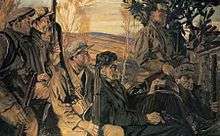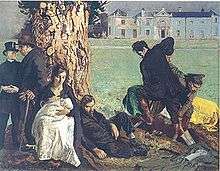Seán Keating
| Seán Keating | |
|---|---|
| Born |
John Keating 28 October 1889 County Limerick, Ireland |
| Died |
21 December 1977 (aged 88) Dublin, Ireland |
| Nationality | Irish |
| Education | |
| Known for | Irish romantic-realist painter |
| Notable work | Men of the South, An Allegory, Night's Candles Are Burnt Out |
Seán Keating (born John Keating, Limerick, 28 September 1889 – Dublin, 21 December 1977) was an Irish romantic-realist painter who painted some iconic images of the Irish War of Independence and of the early industrialization of Ireland. He spent two weeks or so during the late summer on the Aran Islands and his many portraits of island people depicted them as rugged heroic figures. However, he ceased to visit the Aran Islands in 1965.
Life and career

Seán Keating studied drawing at the Limerick Technical School before a scholarship arranged by William Orpen allowed him to go at the age of twenty to study at the Metropolitan School of Art in Dublin. Over the next few years he spent time on the Aran Islands. In 1914 Keating won the RDS Taylor award with a painting titled The Reconciliation. The prize included £50.00 which allowed him to go to London to work as Orpen's studio assistant in 1915. In late 1915 or early 1916 he returned to Ireland where he documented the war of independence and the subsequent civil war. Examples include Men of the South (1921–22) which shows a group of IRA men ready to ambush a military vehicle and An Allegory (first exhibited in 1924), in which the two opposing sides in the Irish Civil War are seen to bury the tri-colour covered coffin amid the roots on an ancient tree. The painting includes a self-portrait of the artist.

Keating was elected an Associate of the Royal Hibernian Academy (RHA) in 1918, and a full member in 1923. One of the cardinal achievements of the Irish Free State in the 1920s was the building, in partnership with Siemens, of a hydro-electric power generator at Ardnacrusha, near Limerick. Between 1926 and 1927 Keating, at his own volition, produced a considerable number of paintings related to this scheme. He exhibited several examples of the paintings in the RHA exhibitions in 1927 and 1928. Most of the paintings are now in the collection of ESB Group.
In 1939 he was commissioned to paint a mural for the Irish pavilion at the New York World's Fair. He was President of the RHA from 1950 to 1962, and showed at the annual exhibition for 61 years from 1914. Although Keating was an intellectual painter in the sense that he consciously set out to explore the visual identity of the Irish nation, and his paintings show a very idealized realism; Keating feared that the modern movement would bring back a decline in artistic standards. Throughout his career he exhibited nearly 300 works at the RHA, and also showed at the Oireachtas.[1]
He died on 21 December 1977 at the Adelaide Hospital and was buried at Cruagh Cemetery, Rathfarnham. The 1978 RHA Exhibition featured a small memorial collection of his work.[2]
Posthumous exhibitions of his work were mounted by The Grafton Gallery, Dublin (1986) and the Electricity Supply Board (1987). Sean Keating - The Pilgrim Soul, a documentary presented and written by his son Justin Keating, aired on RTÉ in 1996.[2]
Recent exhibitions
- 'Seán Keating in Focus' - curated by Dr. Éimear O'Connor, The Hunt Museum Limerick - with eponymous catalogue.
- 'Seán Keating: Contemporary Contexts' curated by Dr. Éimear O'Connor in association with The Crawford Gallery of Art, June–October 2012 - with associated catalogue.
- 'Sean Keating and the ESB: Enlightenment and Legacy' curated by Dr. Éimear O'Connor in association with ESB, The RHA Gallery, July–September 2012 - with associated catalogue available from ESB.
Recent publications
- Éimear O'Connor Seán Keating: Art, Politics and Building the Irish Nation (Kildare: Irish Academic Press 2013)
- Éimear O'ConnorSeán Keating: Responses to Culture and Politics in Post-Civil War Ireland (Dublin: Carysfort Press 2009)
Note: The Keating Estate is in copyright - please seek copyright information from IVARO.[3]
Work in collections
- The Electrical Supply Board in Ireland.
- The National Gallery of Ireland, Dublin, including
- An Allegory (c.1922)
- Crawford Municipal Art Gallery, Cork, including
- Men of the South (1921)[4]
- Trinity College Dublin including
- Portrait of Erwin Schrödinger (1956)[5]
- Limerick City Gallery of Art, Limerick, including
- Kelp Burners
- Centre William Rappard
- 'mural on labour' (1961)[6]
References
- ↑ Snoddy, Theo. Dictionary of Irish Artists: 20th Century, 2nd Edition. Merlin Publishing, Dublin, Ireland, 2002. Pg.300-03. Retrieved Mar. 26, 2008.
- 1 2 Gallery, The Kenny. "The Kenny Gallery - Sean Keating, RHA, Irish Painter, Limerick, Figure, Protrait,".
- ↑ "About us – IVARO".
- ↑ http://www.crawfordartgallery.com/Paintings/SKeating.html
- ↑ McMurry, Sara. "The portrait of Schrödinger by Sean Keating R.H.A.". Trinity College, Dublin. Archived from the original on October 2006. Retrieved 10 December 2012.
- ↑ World Trade Organization (March 2008). The symbolic artwork of the Centre William Rappard (PDF). WTO Secretariat. ISBN 978-92-870-3424-3. Retrieved 17 June 2009.
- Peter Murray (2002), Keating, Seán in Brian Lalor (Ed.), The Encyclopedia of Ireland. Dublin: Gill & Macmillan. ISBN 0-7171-3000-2
- Bruce Arnold (1977), Irish Art, a Concise History (2nd Ed.), London: Thames and Hudson, ISBN 0-500-20148-X
External links
- Short biography on the RTÉ site
- The Wind that Shakes the Barley, 1941, Whyte's Gallery
- Biography at Kenny's Gallery, inc. 2 images.